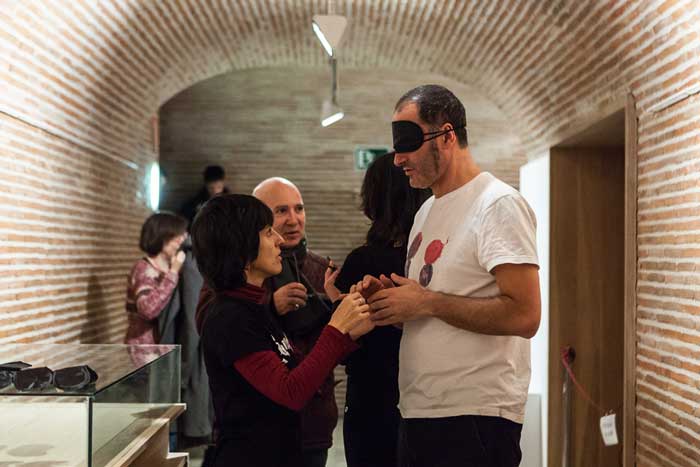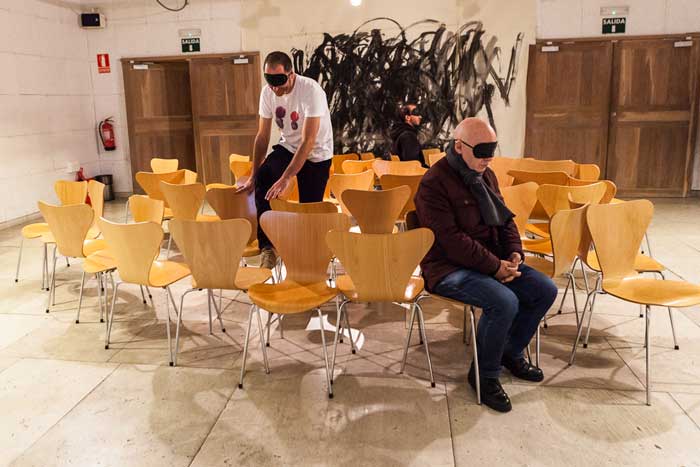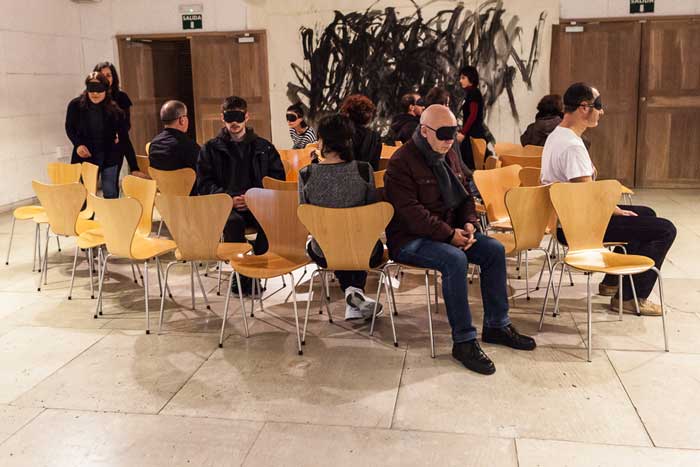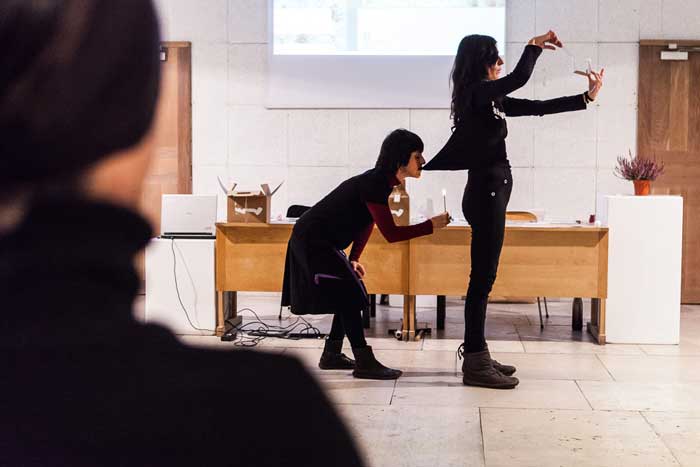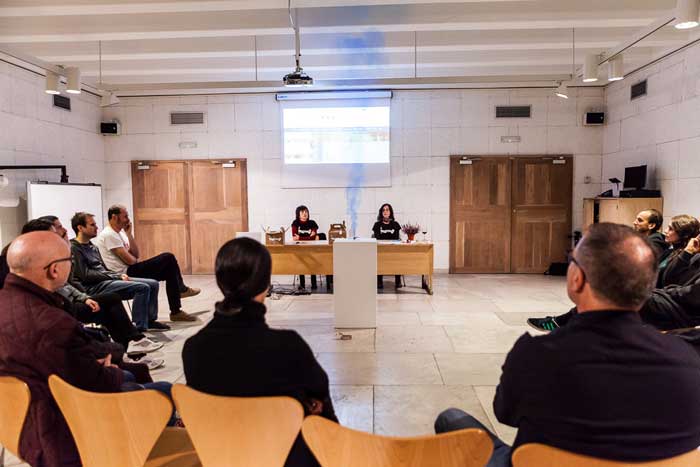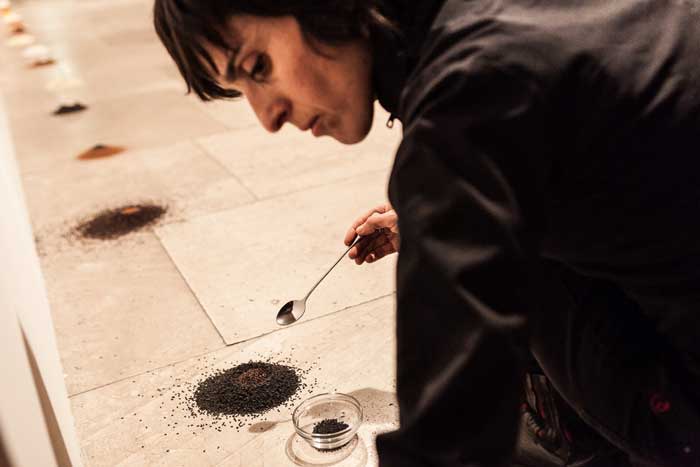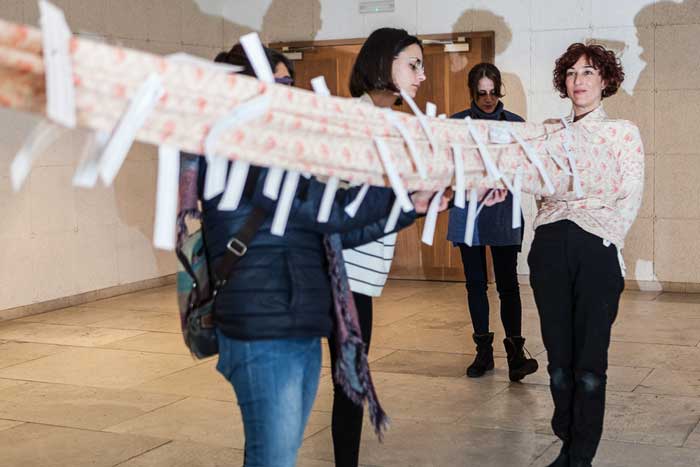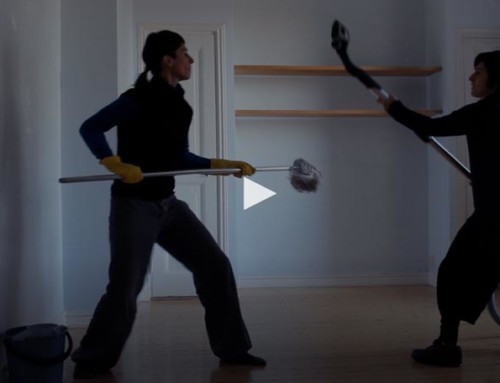
Last October, 2018, EXCHANGE Live Art had the pleasure of being back at the Casa de las Conchas Library in Salamanca presenting the LUNCHBOX object-magazine.
This presentation was accompanied by a happening and the live performances of the artists Ana Gesto, Ana Matey and Isabel León.
The session of the first day began with a happening in which we invited people who wanted to participate to enter a space with their eyes covered. Once inside, they were led through a maze of chairs until they found the one where they wanted to sit. Once seated, they received the following instruction: “your chair is an instrument and you are part of an orchestra”; so a small concert of sounds created with chairs began. In the second part of the happening, the masks were removed and received the following instruction: “the chairs are paint and the space is a canvas”; thus the participants moved the chairs through space, composing in space.
This simple proposal offers the possibility of experimenting with some of the main aspects of action art, such as body, space and time. In the same way, it is a reflection on the subject that occupies us in EXCHANGE Live Art: communication… is there really a listening and dialogue during the creation process shared in the “orchestra” and the “canvas”?
On Monday the 29th, there was also the presentation of the LUNCHBOX object magazine by the artists and creators of the project, Ana Matey and Isabel León. LUNCHBOX is a cardboard box in the shape of a lunchbox containing the 41 pieces (scores and scores-objects) that the participating artists have created for the occasion; with that edition we celebrated more than five years of EXCHANGE Live Art.
In this LUNCHBOX “actionated” presentation, the artists present each of the pieces that make up the box, briefly triggering some of them, carrying out their own interpretation of them. It is a shared action composed of actions as a wink of said scores; a fun way to present this collective work.
En la sesión del martes 30, tuvo lugar una sesión con performances en vivo, donde cada una de las tres artistas participantes en LUNCHBOX llevaron a cabo una acción.
“104”, ANA MATEY.
In this performance, Ana carries out the second version of her score “Lenguage” in which she reviews the different ways of writing and saying the word Language in different languages; a research in process that leads her to discover and learn the existence of numerous languages and dialects, common history, domination through languages, the beauty of the diversity that each one shows …
For this occasion, incorporates an element of the score “SIM Card” by Isabel León, using the mobile phone as a means to share the collection of audios that Ana has been looking for and that thanks to social networks is gradually getting; So far 59 of the 204 languages he has managed to find. In this way in the audios, different people say “language” in their own language; audios that will be activated by the public at the end of the action, creating a kind of concert a Capella.
“Holes”, ISABEL LEÓN.
In this performance, Isabel plays the score “First Step” by the Norwegian artist Ida Grimsgaard in which she invites to make holes that must be filled with the content of the previous hole, again and again …
Isabel creates piles of colors of different flours and seeds in which she performs the action of making holes and stuffing them methodically. To finish an action that would have no end, she fills a hole from which you can not get anything: her own belly button, with which fill the first hole, to close the circle.
She is interested in the simplicity of this score and the repetition that invites us to enter a kind of “quiet trance” in which the shape, colors and distribution of the elements in the space take on the leading role.
“Opera in three acts for Do de Peito.” ANA GESTO.
In this action, Ana interprets her own score “Pulsations”, structured in three parts (or acts): In the first part, at the entrance of the Casa de las Conchas, the artist elaborates more scores (machine-stitched staves) in one action where the sound of the sewing machine envelops us. In the second part, the shortest, cuts the threads that join the scores. In the third part, Ana Matey helps her to unroll the shirt she has created for the occasion with the fabric of some old bed cover of her mother, from which comes out of the chest a long “do of chest” (high C) that recalls a stave in the that the assistants hang the scores, as if they were musical notes.
This action, which seems simple, requires a great effort from both to keep the stave in tension; the public perceives it and each time they put the scores quickly to release them.
Gracias a Guille Ruiz Mantilla por tan estupenda documentación.

